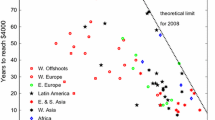Abstract
Technological Adaptation, Trade, and Growth. — Based on Grossman and Helpman’s 1991 seminal work, the authors provide a simple model extension where innovations created in the high-tech sector may be assimilated or adapted by the lowtech sector, thus generating nondecreasing returns in the production function of the latter. When applying a Heckscher-Ohlin framework the authors find that the effects of technological diffusion allow a country relatively scarce in human capital to benefit from nondecreasing rates of growth through its low-tech sector. They test this idea by using a dynamic panel data approach in order to deal with simultaneity and country heterogeneity. Their results are consistent with the predictions of the model and robust to a broad range of definitions of technological intensity.
Similar content being viewed by others
References
Aghion, P., and P. Howitt (1998).Endogenous Growth Theory. Cambridge: MIT Press.
Alonso-Borrego, C., and M. Arellano (1999). Symmetrically Normalized Instrumental-Variable Estimation Using Panel Data.Journal of Business and Economic Statistics 17(1): 36–49.
Arellano, M., and S. Bond (1991). Estimation of Dynamic Models with Error Components.Journal of the American Statistical Association 76 (1): 598–606.
Arellano, M., and O. Bover (1995). Another Look at the Instrumental Variable Estimation of Error-Component Models.Journal of Econometrics 68: 29–51.
Barro, R., and J. Lee (1993). International Comparisons of Educational Attainment.Journal of Monetary Economics 32 (3): 363–394.
Barro, R. J., and X. Sala-i-Martin (1995).Economic Growth. London: McGraw-Hill.
Blundell, R., and S. Bond (1997). Initial Conditions and Moment Restrictions in Dynamic Panel Data Models. Discussion Papers in Economics 97-07. University College, London.
Chong, A., and L. Zanforlin (1999). Technology and Epidemics. Working Paper. Forthcoming in IMFStaff Papers.
De Long, B., and L. Summers (1991). Equipment Investment and Economic Growth.Quarterly Journal of Economics 106(2): 445–502.
Dollar, D. (1992). Outward-Oriented Developing Economies Really Do Grow More Rapidly: Evidence from 95 LDCs, 1976–1985.Economic Development and Cultural Change 40 (3): 523–544.
Easterly, W., N. Loayza, and P. Montiel (1997). Why Has Growth in Latin America Been Disappointing?Journal of International Economics 43:287–311.
Edwards, S. (1995).Crisis and Reform in Latin America: From Despair to Hope. Oxford: Oxford University Press.
Edwards, S. (1998). Openness, Productivity and Growth: What Do We Really Know?Economic Journal 108 (March): 383–398.
Esfahani, H. (1991). Exports, Imports, and Economic Growth in Semi-Industrialized Countries.Journal of Development Economics 35 (1): 93–116.
Ethier, W. (1982). National and International Returns to Scale in the Modern Theory of International Trade.American Economic Review 72 (3): 389–405.
Frankel, J., and D. Romer (1996). Trade and Growth: An Empirical Investigation. NBER Working Paper 5476. National Bureau of Economic Research, Cambridge, Mass.
Frankel, J., and D. Romer (1999). Does Trade Cause Growth?American Economic Review 89 (3): 379–399.
Frankel, J., D. Romer, and T. Cyrus (1996). Trade and Growth in East Asian Countries: Cause and Effect. NBER Working Paper 5732. National Bureau of Economic Research, Cambridge, Mass.
Gomulka, S. (1990).The Theory of Technological Change and Economic Growth. London: Routledge.
Grossman, G., and E. Helpman (1991).Innovation and Growth in the Global Economy. Cambridge: MIT Press.
Harrison, A. (1996). Openness and Growth: A Time-Series, Cross-Country Analysis for Developing Countries.Journal of Development Economics 48 (2): 419–447.
Holtz-Eakin, D., W. Newey, and H. S. Rosen (1988). Estimating Vector Autoregressions with Panel Data.Econometrica 56 (6): 1371–1395.
Kiviet, J. F. (1995). On Bias, Inconsistency, and Efficiency of Various Estimators in Dynamic Panel Data Models.Journal of Econometrics 68 (1): 53–78.
Klodt, H. (1990). Technology Based Trade and Multinationals’ Investment in Europe: Structural Change and Competition in Schumpeterian Goods. Conference on Multinationals in Europe and Global Trade in the 1990’s. Washington, D.C.
Learner, E. (1982).Sources of International Comparative Advantage. Cambridge: MIT Press.
Levin, A., and L. Raut (1997). Complementarities between Exports and Human Capital in Economic Growth: Evidence from the Semi-Industrialized Countries.Economic Development and Cultural Change 46(1): 155–174.
Loayza, N., K. Schmidt-Hebbel, and L. Serven (2000). What Drives Saving across the World?Review of Economics and Statistics 82 (2): 165–181.
Mankiw, G., D. Romer, and D. Weil (1992). A Contribution to the Empirics of Growth.Quarterly Journal of Economics 107 (2): 407–437.
Michaely, M. (1977). Exports and Growth: An Empirical Investigation.Journal of Development Economics 4(1): 49–53.
Pritchett, L. (1996). Measuring Outward Orientation in LDCs: Can It Be Done?Journal of Development Economics 49 (2): 307–335.
Quah, D. (1996). Empirics for Economic Growth and Convergence.European Economic Review 40(6): 1353–1375.
Rivera-Batiz, L. A., and P. Romer (1991). Economic Integration and Endogenous Growth.Quarterly Journal of Economics106 (2): 531–555.
Rodrik, D. (1993). Trade and Industrial Policy Reform in Developing Countries: A Review of Recent Theory and Evidence. NBER Working Paper 4417. National Bureau of Economic Research, Cambridge, Mass.
Romer, P. (1990). Endogenous Technological Change.Journal of Political Economy 98 (5):S71-S102.
Summers, R., and A. Heston (1991). The Penn World Table: An Expanded Set of International Comparisons, 1950–1988.Quarterly Journal of Economics 106(2): 327–368.
United Nations (various years).Yearbook of International Trade Statistics. Geneva: United Nations.
Ventura, J. (1997). Growth and Interdependence.Quarterly Journal of Economics 112 (1): 57–84.
World Bank (1996).The East Asian Miracle. New York: Oxford University Press.
World Bank (1997).World Development Indicators. CD ROM. Washington, D.C.
Ziliak, J. (1997). Efficient Estimation with Panel Data When Instruments Are Predetermined: An Empirical Comparison of Moment-Condition Estimators.Journal of Business and Economic Statistics 15 (4): 419–431.




